Excerpts from Jim Conrad's
Naturalist Newsletter
from the June 19, 2016 Newsletter issued from Hacienda Chichen Resort beside Chichén Itzá Ruins; limestone bedrock; elevation ~39m (~128ft), N20.675°, W88.569°; central Yucatán state, MÉXICO
VELVETSEED FLOWERING
Last December we found a poorly documented small tree, which we called Velvetseed, Guettarda elliptica {see next section}. Since the tree is so poorly known, this week I returned to the same area, hoping to find it in flower, and I was successful. Below, you can see its small, pale yellow flowers clustered among hairy, dewy-wet leaves

The flowers usually occurred in pairs, each with its own pistil and calyx. A side view of two flowers with four corolla lobes arising from each corolla tube is shown below:
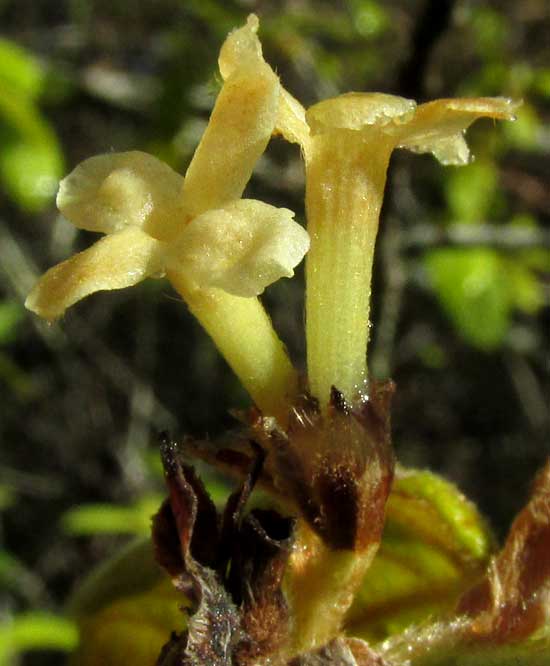
A shot into a flower's mouth finding only two anthers visible at the stigmas level is shown below:
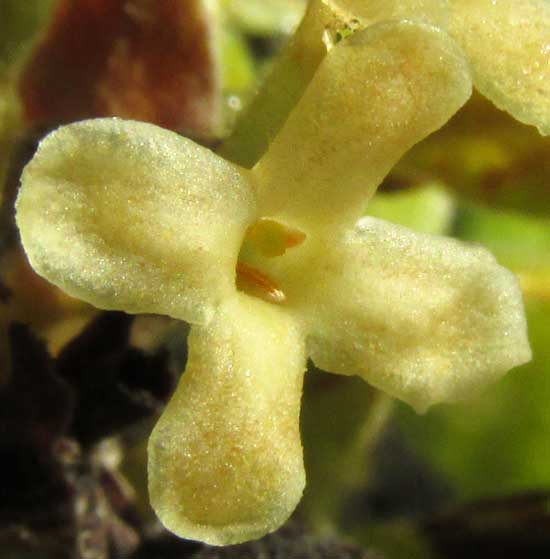
from the December 27, 2015 Newsletter issued from Hacienda Chichen Resort beside Chichén Itzá Ruins, central Yucatán, MÉXICO
Velvetseed FLOWERING
Along an isolated gravel road a tree turned up I'd never seen before, and when that happens it's always a big deal. It bore small, somewhat leathery, hairy leaves, two per stem node, with prominent venation, and what was most exciting, pea-sized, brilliantly red fruits, all shown below.
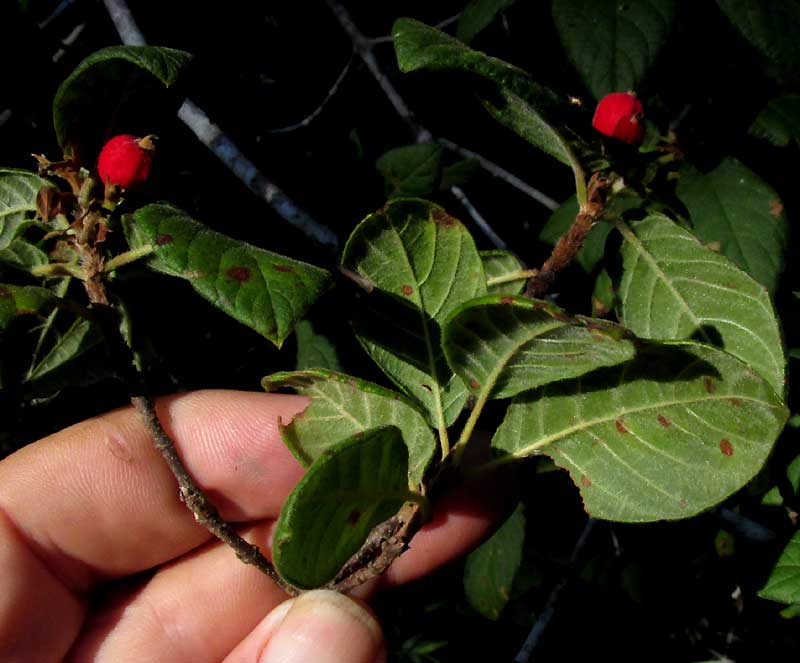
After all these years, how could I have missed something as eye-catching as this? Up close, the fruits were even more unusual, for they bore disperse, very slender, stiff, leaning-over hairs, and a conspicuous brown crown as shown below:
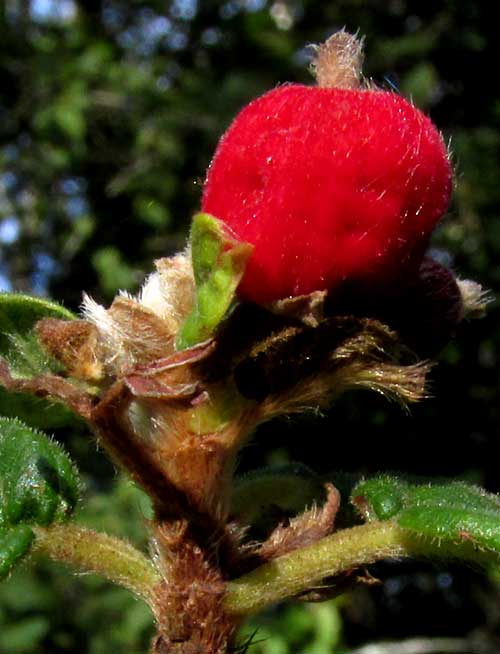
The crown has to be the remains of a calyx, so this fruit has developed from an "inferior" ovary, meaning that the former flower's calyx, corolla and stamens arose above the ovary, not below. This is an important detail, because most flowers are "superior," not "inferior."
In the American tropics, whenever you see a woody bush or small tree bearing opposite leaves and inferior ovaries, the most likely plant family being dealt with is the Coffee or Madder Family, the Rubiaceae, simply because it's such a huge, commonly encountered family. To firm up the diagnosis, you need to look for scale-like "stipules" connecting the tops of the petioles, across the stem. In the above photo stipules should appear, but the stem is so hairy that it's hard to say.
This tree's flowering time had definitely passed, but some immature ovaries were found bearing not only browning calyxes atop them but also withering corollas. Below, you can see that the corollas are also hairy, with corolla lobes atop a long corolla tube:
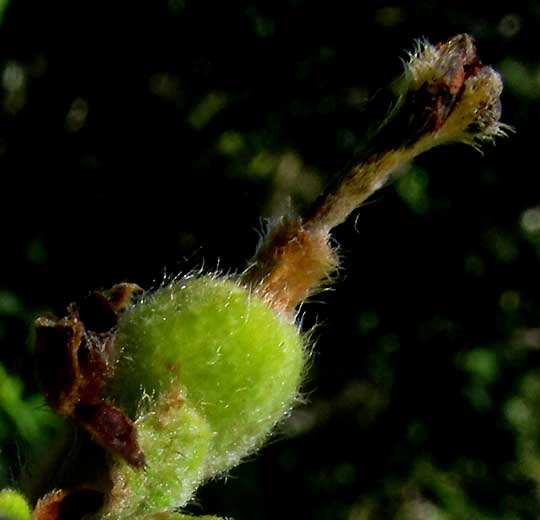
Coffee-Family flowers are often just like this. The fruits were fleshy, containing hard seeds, as seen below:

The tree's bark was pale and blotchy, as shown below:
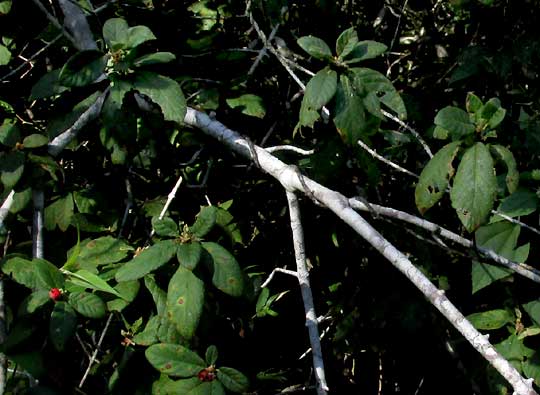
Plenty of searching on the Internet didn't turn up any good pictures matching the above, but the fruits pointed to the genus Guettarda in the Coffee Family, species of which sometimes are called Velvetseed. Paul Standley's 1975 treatment of the Coffee Family, the Rubiaceae, in the Flora of Guatemala (Fieldiana: Botany Vol 24, part XI, #1-3) has a key to species in the genus Guettarda, and in that key our little shrub keys out to GUETTARDA ELLIPTICA. Sometimes species in the genus Guettarda are called Velvetseeds. Guettarda elliptica occurs in southern Florida, northern Belize ans southern Mexico, the Caribbean area, and Venezuela.
issued On September 19, 2019 from near Tepakán, north-central Yucatán state; elevation ~9m (~30 ft), N21.053°, W89.052°; MÉXICO
VELVETSEED'S HAIRY LEAF UNDERSURFACES
Both Guettarda elliptica and G. gaumerii commonly occur in the Yucatan, and they're very similar. One feature differentiating them is that the leaf bases of G. gaumerii are broad to rounded or even somewhat eared (auriculate), while leaf bases of Guettarda elliptica narrow to the petiole (attenuate). Leaf bases on flowering branches at the top of this page appear to be rounded to auriculate, while leaves -- fairly certainly from the same tree -- of older, fruiting stems are attenuate. This has caused me some doubt about which species this was.
However, at this date more images of the two species are available and here at Tepakán we have trees with fruits that appear to be identical to the ones above, and now I know to pay attention to hairs on the trees' lower leaf surfaces. Standley describes hairs on the lower leaf surfaces of Guettarda elliptica as "very closely appressed" -- lying next to the blade surface -- as opposed to "spreading hairs" of G. gaumeri. Below, you can see the hairs of our Tepakán plant's lower leaf surface:
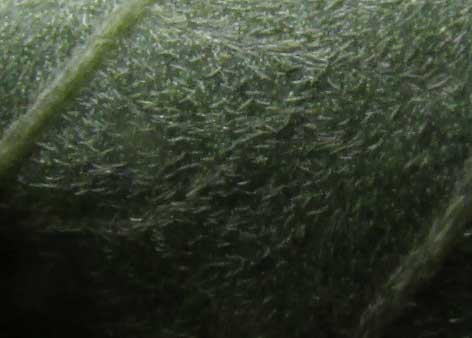
They "very closely appressed," so Guettarda elliptica Below is a fruit from the Tepakán tree with appressed hairs:
